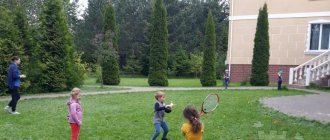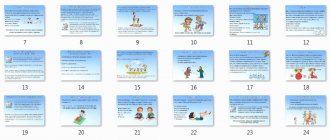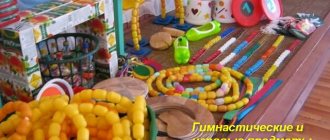“Organization and planning of routine moments in kindergarten”
Consultation
on the topic of:
“Organization and planning of routine moments in kindergarten”
Prepared by:
teacher of 1st category
Volkova Olga Sergeevna.
Goal: To acquaint teachers (young specialists) with methodological recommendations for organizing and planning routine moments; their significance for the development of intellectual and physical qualities; prerequisites for educational activities, on the formation of a general culture and the development of personal qualities of a preschool child.
The solution to program educational problems is solved not only within the framework of direct activities, but also during routine moments.
Let's consider the need and possibility of organizing the life and activities of a child in a preschool institution from the perspective of modern value-target guidelines set by the Federal State Educational Standard for Education.
“formation of a common culture, development of physical, intellectual and personal qualities, formation of educational activities that ensure social success, preservation and strengthening of the health of preschool children”
I would like to dwell on the problem of forming a general culture and developing the personal qualities of a preschool child in the process of organizing routine moments.
The main components of general culture are:
- Culture of health (culture of nutrition, culture of sleep, culture of life safety);
- Social culture (culture of behavior and communication, culture of activity).
When planning routine moments, you should pay attention to:
- The organization of routine moments should be aimed at the formation of a general culture and the development of the child’s personal qualities.
- The organization of each of the routine moments should ensure the comprehensive development of the child.
- During the organization of regime moments, the unity of the objectives of the educational process of preschool children should be ensured.
- The organization of regime moments should “be built taking into account the principle of integration of educational areas in accordance with the age capabilities and characteristics of children, the specifics and capabilities of educational areas.”
In a preschool educational institution, the normative basis for organizing routine moments is the daily routine (which is approved by the head).
The daily routine provides for the organization of joint activities with the teacher and independent activities of children both during scheduled moments and between them.
Options for organizing various types of activities at various scheduled times are very diverse and depend on the age of the children, their interests, seasonality and events.
In the daily routine, we can highlight the following routine moments:
- Reception of children, examination, games, morning exercises
- Preparation for breakfast, breakfast
- Games and children's activities
- GCD
- Preparing for a walk, walk
- Returning from a walk, preparing for lunch and lunch
- Getting ready for bed, naps
- Getting up after sleep, water procedures, hardening activities
- Games, independent activities for children
- Dinner
11. Walk, go home
In each of the listed routine moments (except for the morning reception and going home) there is always a preparatory and final stage (preparation for breakfast, breakfast, completion of breakfast).
Each regime moment may include the following organizational aspects (structural components):
- Preparing for a routine moment (for a walk, for eating, etc.)
- The routine moment itself (walking, eating, sleeping)
- Completion of a routine moment (return from a walk, gradual ascent, etc.)
You should not forget about other forms of work when organizing routine moments:
- Duty;
- Interaction with parents;
- Meeting of children;
- Inspection;
- Etc.
Reception of children, examination, games, morning exercises
Reception of children by a teacher can be carried out in a group, reception room or at the site. The most important thing is to create a good mood for both the child and his parents. This provides a positive attitude for the coming day and is the key to mutual understanding and interaction between the kindergarten and the student’s family.
During the morning reception, it is necessary to pay attention to the appearance of the children. Of course, the children who come should greet the teacher and other children in the group, join in the games, talk quietly, and not shout.
The teacher provides interesting, meaningful activities for children and makes sure that they do not quarrel or interfere with each other. If a child is shy, self-conscious, not in the mood, or for some other reason cannot independently choose an activity, the teacher should help him: connect him to playing children, help in choosing toys, play with the child, or give him some specific activity. order.
The teacher also provides conditions for varied and interesting independent activities of children in a group or in the area. To do this, he systematically changes the interior of the group room, introduces new (or already forgotten) aids that will contribute to the emergence of playful or creative ideas in children.
In the morning, the teacher conducts gymnastics with the children. At the same time, the teacher works together with the children and, if necessary, corrects and corrects the children’s exercises.
Preparation for breakfast, breakfast
The organization of washing is carried out gradually, in small groups of children. Children should be reminded of the rules of behavior in the washroom - children should not splash water, should maintain order and cleanliness, immediately turn off the water after washing their hands and under no circumstances leave the taps open. It is also necessary to pay attention to the actions of children - they must roll up their sleeves, soap their hands and perform other procedures at the sink. Children should know that they can only use their own towel, and after washing they need to carefully hang it in its place. These procedures should be carried out in a calm, friendly environment, which will ensure a good mood for children during meals.
When organizing breakfast, the teacher draws the children’s attention to how the tables are set for breakfast and evaluates the children on duty. Depending on the menu, you can clarify the names of some dishes. It is important to note the care of nannies and cooks for children, and to outline in a few words the importance and necessity of these professions.
During the meal, the teacher constantly monitors the children’s posture and motivates them to eat all the food offered. However, if the child has no appetite and refuses to eat, then it is better not to force it. Forced eating will not do anything good for either the physical or psychological health of the child. Also, during the breakfast process, the tasks of developing cultural and hygienic eating habits are solved.
Games and children's activities
In the group, the teacher creates conditions for children to organize different types of activities, and the plan reflects for which types of activities the subject-development environment has been created - indicating the name and purpose of the activity. When working individually with children, it is necessary to indicate both the topic and the goal, with clarifying details.
Direct educational activities
Direct educational activities should flow organically from the types of activities that children were engaged in at the previous stage. GCD is carried out according to the calendar plan, which indicates the program content and goals.
Preparing for a walk, walk
Before going for a walk, it is necessary to restore order in the group: collect toys and place them in their places, remove manuals and materials that were used in direct educational activities.
Before getting dressed, the teacher reminds children of the rules of conduct in the dressing room. In this regime moment, the teacher develops in children the skills of dressing and the culture of behavior when dressing, solves a wide range of educational tasks: the name of clothing and its purpose, the name of the details of clothing and the activation of the dictionary on the topic “Clothing”. The teacher draws the children’s attention to the sequence of dressing, and before going out for a walk, to the children’s appearance. If during the process of dressing someone makes obvious mistakes, the teacher eliminates them together with other children in the group, while making the children want to help each other and stopping ridicule from their peers.
Organization of a walk
.
During the walk, the teacher helps children organize interesting and varied activities. To do this, there must be toys and auxiliary equipment, the rules for handling which the teacher teaches children during a walk or previously in a group. During the walk, the teacher has the opportunity to observe the content of the games and the children’s relationships and adjust them if necessary.
Before leaving the walk, the children tidy up the area and collect the materials they take away. Before entering the kindergarten, the children wipe their feet and learn to enter calmly, without jostling, arguing, or interfering with each other. In the locker room, the teacher monitors the process of changing clothes and instills in children a careful attitude towards things and neatness skills.
Returning from a walk, preparing for lunch and lunch
See Preparing for Breakfast, Breakfast.
Preparing for bed, naps
IMPORTANT! After lunch, under no circumstances should you immediately put your children to bed. After eating, at least 20 minutes should pass.
It is better that the period of preparation for bed be calm and balanced. Children are not recommended to be distracted by noisy games or emotional conversations. When undressing, the teacher develops a caring attitude towards things and neatness. The bedroom environment should be calm and relaxing. A gentle lullaby, folk nursery rhymes and sayings will help create the right mood and a positive attitude towards daytime sleep. It is necessary to check whether the children are comfortable in their beds, or even better, approach each one, straighten the blanket, pat them on the head and wish them a restful sleep. This way you will show your child your love and care, and create a peaceful mood that promotes good sleep.
Getting up after sleep, water treatments, hardening activities.
The rise is carried out gradually, as the children wake up; after the rise, hardening procedures are organized, the implementation of which is coordinated by the teacher with the nurse and the parents of the pupils.
After sleep, children consolidate their independent dressing skills, and the teacher helps them if necessary. Work continues to cultivate accuracy and independence.
Games, independent activities for children
It is organized similarly to the item “Games and children's activities”.
Preparing for afternoon tea, afternoon tea
It is organized similarly to the item “Preparing for breakfast, breakfast.”
Games, walks, children going home
It is organized similarly to the points “Preparing for a walk”, “Games” and “Reception of children”.
During an evening walk and in the presence of the child, the teacher can inform parents about his developmental achievements and successes in the group. For clarity, it would be nice to demonstrate the children's work. In addition, the teacher informs parents about the problems the child has encountered and ways to solve them, and provides advice on issues of interest to parents.
IMPORTANT! The order is exactly this: first positive, then negative. Whatever the child is, no matter how much inconvenience he causes you, you must definitely find the positive and praise him in the presence of his parents. And only then about the problems. Tactfully, unobtrusively, competently, but persistently. And an individual approach to each family is required: to whom, how and what can be said and what cannot be said.
Separately, it is worth paying attention to the departure of a child from kindergarten. The child must not forget about the rules of good manners, namely, say goodbye to the teacher and the children of the group. The teacher and parents need to form a positive attitude of the child towards kindergarten and prepare the children for the next visits.
Why does a child need a regime?
A child's daily routine is often based on their diet. Children get used to the fact that in the morning they get up, wash, have breakfast, study or walk, then have lunch, rest, and so on until bedtime. If this separation does not exist, then problems with food begin, because the child can snack on yogurt, a bun, or fruit at any time. As a result, he does not feel the hunger that is necessary for a full meal.
It is interesting that often in a family where dietary routines are not followed, parents do not worry about maintaining the daily routine in general. This leads to the fact that the time of waking up and falling asleep is always different, daytime sleep is an inconsistent phenomenon.
It has been proven that children are conservatives. They feel much calmer when they know what awaits them next, and react sharply to changes in planned actions.
The behavior of children who do not have a daily routine is characterized by frequent emotional outbursts in the form of hysterics for any reason; their level of aggressiveness and conflict may increase. It's difficult to get babies to sleep at night. If he wakes up late, he therefore does not rest during the day. The nervous system is overloaded, making it difficult for the child to readjust and sleep peacefully.
To prevent this from happening, it is better to stick to a certain schedule, even if not very strict.
Summarizing
Analyzing the regime moments in kindergarten, you can notice that some points remain unchanged for all age groups. These include:
- Morning reception of children.
- Eating.
- Developmental activities.
- Game activity.
- Walk.
However, preschool leaders try to develop a daily routine in such a way as to take into account the age characteristics of children in each group.
Developmental activities for children
Regular moments in the garden necessarily include developmental classes in mathematics, speech development, drawing, modeling, physical education, music, consolidation of everyday skills, and others.
Most often, classes last no more than half an hour, because children at that age are not yet able to maintain attention for a long time, which is why they need a constant change of activity.
Naturally, the duration of classes in the nursery group differs from that in the preparatory group.
Preparing for quiet time and getting up
Lunch is about the same as breakfast. Here, too, duty officers are appointed and given feasible tasks.
Regular moments are also observed after meals, when preparation for bed begins. To do this, the teacher must strictly monitor discipline in the group so that the children do not play out and make noise, creating a mood for relaxation. The environment should be calm so that the guys can relax.
In the process of preparing for bed, the teacher is faced with the task of continuing to instill in children a caring attitude towards things and encouraging positive emotions regarding daytime rest.
During the rise, children should not be distracted by extraneous things, but immediately get dressed and then wait for the others. At this time, you can offer your child a quiet game, for example, putting together a simple puzzle.
Another weighty argument in favor of the regime
Sometimes parents are satisfied with such a life when the child is free to make his own decisions. However, problems begin when it comes time to go to preschool. Regular moments in kindergarten are strictly observed, and it will be very difficult for a child to adapt if he is not used to them.
Therefore, parents are strongly advised to familiarize themselves with the daily routine at the preschool educational institution and organize their day in advance as close as possible to the kindergarten schedule. This will make the child’s life easier while getting used to new conditions.




